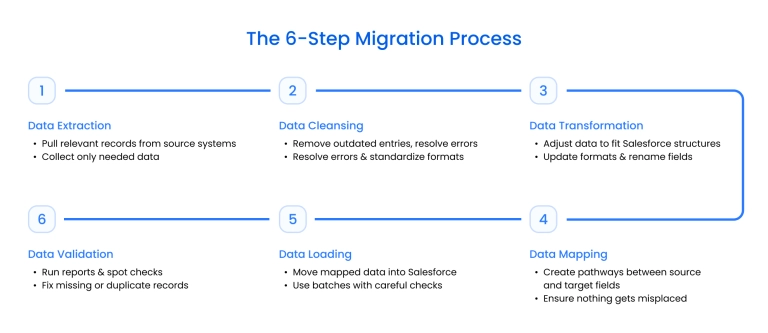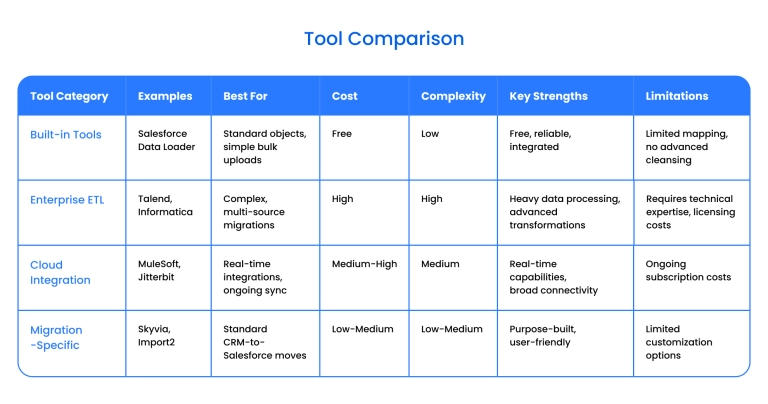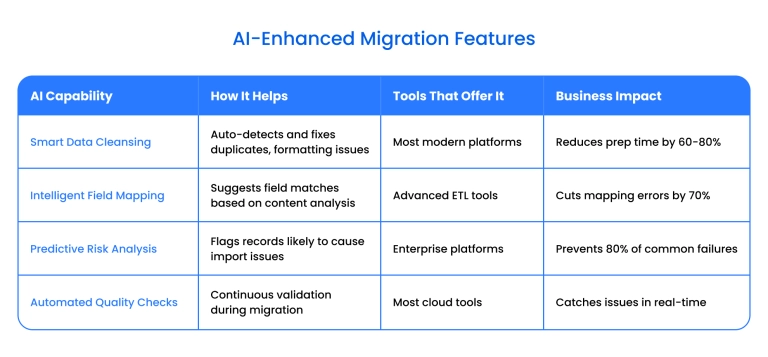Typical CRM implementations achieve positive ROI within 12-13 months , yet only 28% of enterprise applications are currently connected. This integration gap represents massive untapped potential for businesses planning Salesforce migrations.
Moving critical business data into Salesforce doesn't have to feel risky. With proper planning, organizations achieve up to 299% ROI over three years while avoiding the hidden pitfalls that derail migrations.
95% of companies cite integration challenges among AI adoption barriers, making seamless data migration more critical than ever.
This guide walks you through every phase of Salesforce data migration, mixing practical case studies with proven strategies. Our goal: help you avoid expensive mistakes and keep sensitive data safe.
- Get the full Salesforce migration lifecycle – from extraction to post-migration checks
- Master smart planning and risk assessment before you start
- Compare migration tools, including AI-powered choices, for every scenario and business size
- Learn change management tactics to boost user adoption and minimize disruption
- Discover budgeting tips, ROI tracking, and strategies for long-term scalability and security
Salesforce data migration: Definition, lifecycle, and scenarios
Does shifting your data into Salesforce feel overwhelming? You're not alone. Moving customer info, sales records, and business processes from legacy platforms is a challenge that can make even the most seasoned leader anxious. Here's where having a clear roadmap – and the right partner – makes all the difference.
What exactly is salesforce data migration?
Salesforce data migration means moving your business records from one system – a legacy CRM, spreadsheets, or another cloud platform – into Salesforce. We're talking about customer details, leads, sales notes, and even attachments. It's not just about moving files; it's about keeping everything accurate and connected. The right migration protects data quality, supports day-to-day business, and clears the path for future growth.
The best migrations cover every detail: field mapping, deduplication, and cleaning up outdated info. Doing it right avoids issues like duplicate contacts, missing data, or lost deals.
The migration lifecycle: Six key steps
Think of migration like delivering precious cargo – it's all about getting things safely from point A to point B, without surprises:

Common migration scenarios
No two businesses are alike. Here's how different Salesforce migration strategies handle your unique situation:
- Switching from legacy CRM: Older systems often hold complex records or outdated details. Careful extraction and transformation help preserve history and filter out what's no longer needed.
- Migrating from another cloud CRM: Tools like HubSpot or Zoho have different structures and fields—detailed mapping and cleansing smooth out the transition and avoid mismatches.
- Consolidating multiple orgs: Companies with separate Salesforce orgs face tricky challenges due to mergers or siloed teams. Deep mapping and conflict resolution help data come together without losing accuracy.
- Industry-specific needs: Healthcare , finance, and manufacturing all involve strict regulations. We ensure sensitive data, user permissions, and compliance standards are met throughout migration.
Partnering with experts gives you confidence and control at every step. Binariks guides your team, offering ongoing support and setting up sustainable solutions for future growth.
Strategic pre-migration planning and risk assessment
Migrating to Salesforce can feel like juggling fire – one slip risks business function or reputation. You're alone if you're worried about data loss, timeline slips, or missed stakeholder needs. That's why strong planning is non-negotiable.
With Binariks as your migration partner, you get tested systems and support – not just a checklist.
Pre-migration planning: Step-by-step prep
Before you change a single record, gather your team and build your plan. Here's what smart pre-migration looks like:
- Engage stakeholders: Sales, marketing, IT, and leadership must be involved from the start. More voices now means fewer emergencies later.
- Audit your data: Hunt for dirty, duplicated, or irrelevant records. Flag issues ahead of time.
- Analyze risks: Spot potential pitfalls, such as mapping errors, integration gaps, or compliance snags.
- Backup everything: Always keep a fresh copy of your old system. If a step goes sideways, recovery is simple.
- Set your timeline: Map key milestones and leave room for obstacles. Rushing causes mistakes – planning means calm problem-solving.
Risk assessment: Solve problems before they begin
Ignoring risk makes future headaches a guarantee. Our clients who succeed take risk assessment seriously – flagging issues before migration starts.
Our proven strategy:
- List known risks: What tripped up previous migrations? Consider outages, permission errors, or weird custom fields.
- Score and prioritize: Pinpoint the highest-risk issues that could stop your project or disrupt business. Early fixes bring long-term ease.
- Prep mitigation plans: Know how to respond to challenges. No scrambling: just clear, ready action.
We integrate these steps into every migration, so you stay on track and avoid expensive surprises.
Choosing migration tools and using ai to make work easier
Let's be honest: picking the wrong tool or partner can derail your entire migration. Your choices now define how easy, secure, and sustainable your move will be. We help you make smart decisions and set you up to focus on your business – not just technical headaches.
Comparing migration tools: Features and fit
There's no universal solution – your needs shape what works best. Here's how the main options compare:

How AI makes migration smarter
Modern AI isn't just for chatbots – it's changing how teams move data to Salesforce.

Finding the right vendors and partners
It's about the team as much as the tech. Here are must-haves before signing any contract:
- Proven experience: Has the partner moved complex Salesforce data before? Ask about project outcomes, not promises.
- Real AI features: Combining AI with Salesforce helps solve your real problems, or is it just marketing fluff?
- Scale and integration: Can their tools handle your volume and tech stack?
- Security and compliance: Insist on encryption, certifications, and audit details.
Getting migration right: Execution and managing change
Moving data to Salesforce isn't just technical – it's about managing people, process, and business. You're worried about downtime, data issues, or skeptics among your team. You need reliability and skilled guidance, not vague promises. Our process is centered on keeping your people informed, data safe, and workflows running.
Phased migration, monitoring, and safe rollbacks
We recommend breaking the migration into phases. Instead of moving every record overnight, tackle smaller groups – test, then tweak. This way, you catch problems early and keep momentum.
Real-time dashboards tell you what's working or not. When a record misses, you see it instantly and fix it before it grows. That's true peace of mind.
Need a backup? A rollback plan lets you hit "undo" if something goes wrong. It's your get-out-of-jail-free card that keeps business running and stress low.
Smart integration and security
Your new Salesforce must play well with HR, finance, and other systems. Integration isn't an afterthought – we recommend secure APIs, deep data mapping, and ready-made connectors for smooth setup.
Regulations like GDPR or HIPAA matter. At Binariks, we track every step, use encryption, and configure access so only those who need it see sensitive data. Security includes spotting weak points, checking for potential leaks, and keeping everything audit-proof.
Build your migration safety net by:
- Using secure transfer protocols
- Carefully mapping fields between systems
- Updating permission settings across apps
- Tracking and logging each batch moved
Keeping teams on board: Change management that works
Even the best technical work flops if people aren't ready or willing to use the new system. Change management is about partnership – working with leaders to build positive momentum, and offering hands-on training for everyone else.
- Keep the communication flowing with clear timelines and expectations
- Identify affected users so no group feels blindsided
- Open channels for feedback and support
- Run practical, focused training workshops
Migration is about building trust – helping users adjust, learn, and feel confident.
After migration: Validation, training, and ongoing improvement
Seeing "Migration Complete!" feels great – but problems can arise if you stop there. Missing data, confused staff, or a flood of support tickets can erase gains. That's why post-migration care is just as critical as the move.
Auditing and validation
Double-check everything once your data lands:
- Automated comparison tools: Run reports that quickly spot missing or changed records.
- Manual reviews: Sample data in key fields and fix issues before users notice.
- Process checks: Make sure automations and workflows run the way you expect.
Continuous improvement: Staying ahead
Migration isn't one-and-done – the benefits grow with regular updates and feedback.
- Get honest input from users: Surveys reveal pain points and bright spots.
- Quarterly reviews: Analyze issues, metrics, or workflow stalls.
- Make targeted updates: Refining dashboards or automations boosts productivity and morale.
You're never left alone after the migration. Binariks team's ongoing support turns a simple data transfer into a foundation for growth.
Managing costs: Budgeting, ROI, and planning ahead
You're focused on results, not runaway spending. Getting financials right means more precise planning, a smarter strategy, and no nasty surprises. We keep your numbers on track so you can scale confidently.
Planning your migration budget
- Create a detailed roadmap: Break down each key step and assign a realistic budget and timeline.
- Prioritize what matters: Only migrate what moves your business forward. Archiving old or unused data cuts clutter and cost.
- Find cost-savers: We'll help you discover vendor discounts, smarter licensing, and automation opportunities that keep budgets lean.
- Add a buffer: Set aside 10–15% for unexpected twists – migration always surprises, and a safety net pays off.
Every day spent fixing mistakes chips into your bottom line. Planning right saves money both now and later.
ROI and total cost of ownership
Money spent on migration is only wise if returns follow. Here's how we help you make sense of the investment:
- Track big-picture gains: Not just lower costs, but better sales visibility, productivity, and customer insights.
- Account for all costs: Include licensing, integration, support, and maintenance – look beyond just the migration itself.
- Set measurable benchmarks: According to Gartner, careful CRM migration planning boosts payback chances by 47% within two years.
Risk-ready financial planning
Financial planning is built in from day one – not added last minute.
- Run what-if scenarios: What if timelines slip or third-party costs pop up? This keeps budgets flexible and realistic.
- Involve the right people: Bring finance, IT, and business leads together at the planning table.
- Commit to ongoing support: We help you upskill staff and set guardrails for maintenance, so costs and risks stay manageable.
Future-proofing: Scalability, privacy, and security that lasts
Your enterprise needs solutions that scale without breaking under pressure. Future-proof planning means building flexible systems that grow with your business while maintaining security and compliance.
Essential elements for scalable migration:
- Design plug-and-play integrations for easy expansion
- Implement zero-trust security with multi-factor authentication
- Ensure GDPR and CCPA compliance from day one
- Schedule regular audits and system reviews
- Plan for aggressive upgrade cycles and new integrations
Choose the right migration partner
Success depends on partnering with experts who offer proven enterprise experience, strong security credentials, and ongoing support that evolves with your needs.
Effective Salesforce migration transforms how your business operates, connects teams, and prepares for tomorrow's challenges. It's not just about moving data – it's about building a foundation for sustained growth and competitive advantage.
Ready to future-proof your enterprise with a migration strategy tailored to your goals? Contact Binariks for expert guidance that ensures your Salesforce implementation delivers lasting value and scalable success.
Share

